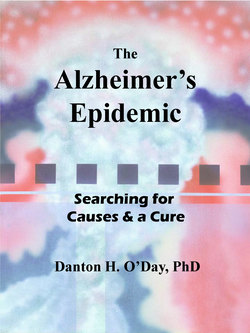Читать книгу The Alzheimer's Epidemic - Danton O'Day - Страница 26
На сайте Литреса книга снята с продажи.
How Does Alzheimer’s Start?
ОглавлениеWhat is the trigger for this devastating disease? This is the big question. It will also be the most difficult to determine. If we are ever going to prevent Alzheimer’s disease from developing, we need to know when it actually starts. What is the trigger? Is it a single event or many simultaneous or temporally defined events? Is it the same for all cases or are there many initiating causes that vary from individual to individual? At the very least it will be critical to know the earliest, if not the first, changes that underlie the onset of the disease. Knowing how Alzheimer’s initiates and progresses will allow biomedical scientists find ways to prevent, ameliorate and ultimately cure the disease.
The results of a diverse number of studies, meetings and conferences suggest that the underlying events of Alzheimer’s disease occur long before the disease becomes evident. As summarized in the previous paragraph and indicated in Figure 3.3, the initiating events (cause or causes) that set the disease in motion are unknown. The same goes for the number of years it takes for the resulting changes to take hold. However, some advancement has recently been made in this area. The initial underlying but unknown changes in the brain are believed to be the pathophysiological underpinnings of Alzheimer’s disease. They presage the clinical aspects of the disease. As mentioned, there is a long asymptomatic phase or latency period between the pathophysiological changes that occur in the brain and the clinical aspects which we see as Alzheimer’s. During the latency period or presymptomatic phase, amyloid beta builds up in specific brain regions, transforming a person without symptoms into one who shows symptoms of cognitive impairment. Until very recently, scientists suggested that there was around a 10-year latency period before the cognitive effects of Alzheimer’s become evident. With that timeline extended to as much as several decades, it opens up a much wider window for early diagnosis and therapeutic intervention. But what are the targets for diagnosis and intervention?
Investigations into the early events in Alzheimer’s are focusing on potential biomarkers for the disease which will permit early diagnosis—the first step in being able to devise a cure in the long term and in helping the patient fight the disease in the short term. In short, current approaches to dealing with Alzheimer’s disease are taking the same approach used for other diseases such as heart disease, diabetes and cancer, to name a few. For example, with heart disease, it has been shown that high LDL (low-density lipoprotein) is bad. So doctors help individuals lower the amount of this bad form of cholesterol in their blood by regulating their diet and/or prescribing medicine. If the causative agent of Alzheimer’s disease, assuming there is one or at most a few, could be determined, then the quest for a cure is possible. Alzheimer’s, however, may be more like cancer where multiple causes lead to multiple forms of the disease in a diversity of human tissues. Since the brain is the primary tissue of assault in the disease, then it is believed the cause or causes may be few in number but that is yet to be learned.
Thus the presymptomatic stage—the stage when no symptoms are evident—is a stage when the events of Alzheimer’s disease are set in motion likely in part by the accumulation of amyloid beta. This is also called the preclinical stage because there are no symptoms that can be identified by a clinician. The changes that are occurring are happening at the cellular level, in the brain neurons where all thinking and reasoning occurs. Later we’ll look at some work that is being done to identify attributes of the preclinical or presymptomatic stage that will allow for early detection and intervention. Identifying these changes could one day point to the initiating events of the disease which in turn may provide hope for a cure.
